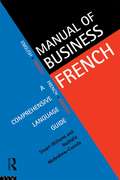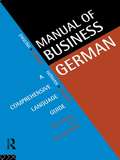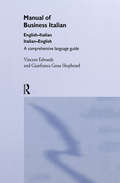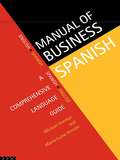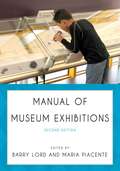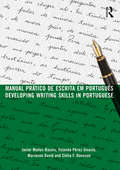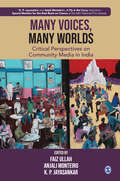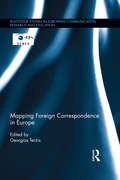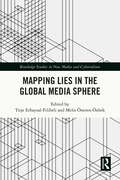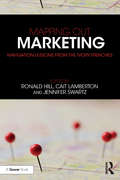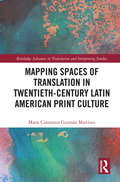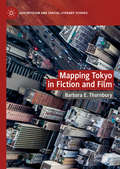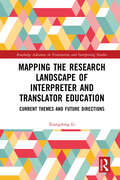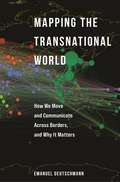- Table View
- List View
Manual of Business French (Manuals Of Business Ser.)
by Stuart Williams Nathalie McAndrew CazorlaManual of Business French is the most comprehensive, single-volume reference handbook for students and professionals using French. Designed for all users, no matter what level of language skill, this manual comprises five parts: * A 6000-word, two-way Glossary of the most useful business terms * A 100-page Written Communications section giving models of 50 letters, faxes and documents * An 80-page Spoken Situations section covering face-to-face and telephone situations * A short reference Grammar outlining the major grammar features of French * A short Business Facts section covering esential information of the country or countries where French is used Written by an experienced native and non-native speaker team, this unique volume is an essential, one-stop reference for all students and professionals studying or working in business and management where French is used.
Manual of Business German: A Comprehensive Language Guide (Manuals Of Business Ser.)
by Paul Hartley Gertrud RobinsManual of Business German is the most comprehensive, single-volume reference handbook for students and professionals using foreign languages.Designed for all users, no matter what level of language skill, it comprises five parts:* A 6000-word, two-way Glossary of the most useful business terms* A 100-page Written Communications section giving models of 50 letters, faxes and documents* An 80-page Spoken Situations section covering face-to-face and telephone situations* A short Reference Grammar outlining the major grammar features of German * A short Business Facts section covering essential information of the country or countries where German is usedWritten by an experienced native and non-native speaker team, this unique volume is an essential, one-stop reference for all students and professionals studying or working in business and management where German is used.
Manual of Business Italian: A Comprehensive Language Guide (Manuals Of Business Ser.)
by Vincent Edwards Gianfranca Gessa ShepheardManual of Business Italian is the most comprehensive, single-volume reference handbook for students and professionals using Italian.Designed for all users, no matter what level of language skill, this manual comprises five parts: * A 6000-word, two-way Glossary of the most useful business terms * A 100-page Written Communications section giving models of 50 letters, faxes and documents * An 80-page Spoken Situations section covering face-to-face and telephone situations * A short Reference Grammar outlining the major grammar features of Italian * A short Business Facts section covering essential information of the country or countries where Italian is used Written by an experienced native and non-native speaker team, this unique volume is an essential, one-stop reference for all students and professionals studying or working in business and management where Italian is used
Manual of Business Spanish: A Comprehensive Language Guide (Manuals Of Business Ser.)
by Michael Gorman Maria-Luisa HensonManual of Business Spanish is the most comprehensive, single-volume reference handbook for students and professionals using Spanish.Designed for all users, no matter what level of language skill, it comprises five parts:* A 6000-word, two-way Glossary of the most useful business terms* A 100-page Written Communications section giving models of 50 letters, faxes and documents* An 80-page Spoken Situations section covering face-to-face and telephone situations* A short Reference Grammar outlining the major grammar features of Spanish* A short Business Facts section covering essential information of the country or countries where Spanish is usedWritten by an experienced native and non-native speaker team, this unique volume is an essential, one-stop reference for all students and professionals studying or working in business and management where Spanish is used.
Manual of Museum Exhibitions
by Barry Lord Maria PiacenteDrawing on years of experience and top-flight expertise, Barry Lord and Maria Piacente detail the exhibition process in a straightforward way that can be easily adapted by institutions of any size. They explore the exhibition development process in greater detail, providing the technical and practical methodologies museum professionals need today. They’ve added new features and expanded chapters on project management, financial planning and interactive multimedia while retaining the essential content related to interpretive planning, curatorship, and roles and responsibilities.
Manual prático de escrita em português: Developing Writing Skills in Portuguese (Developing Writing Skills)
by Javier Muñoz-Basols Marianne David Yolanda Pérez Sinusía Clélia F. DonovanManual prático de escrita em português/Developing Writing Skills in Portuguese provides intermediate- and advanced-level students with the necessary skills to become competent and confident writers in the Portuguese language. With a focus on writing as a craft, Manual prático de escrita em português offers a rich selection of original materials including narrative texts, expository essays, opinion pieces and newspaper articles. Each chapter covers a specific kind of writing and is designed to help tackle the material in small units. The book aids students in crafting clear, coherent and cohesive texts by means of guided practice and step-by-step activities. Suitable for use as a classroom text or as a self-study course, this book is ideal for students at level B2 – C2 of the Common European Framework for Languages or at Intermediate High – Advanced High on the ACTFL proficiency scales.
Manuale delle Microespressioni: Ci sono delle informazioni che il viso non può nascondere
by Danilo H. GomesLe microespressioni costituiscono un mistero per la stragrande maggioranza delle persone. Attraverso la lettura della gestualità del viso potremmo aiutare molte persone che nascondono la propria tristezza per orgoglio o per paura. Con un buon manuale a disposizione, la lettura dei volti diventa più semplice. MANUALE DELLE MICROESPRESSIONI riassume le microespressioni legate alle 7 emozioni universali di base e 3 reazioni di risposta interne che vengono espresse dal viso umano, accompagnate da immagini dettagliate per una migliore comprensione. Questo libro può essere utilizzato come manuale di base per la lettura delle microespressioni o una guida per approfondire lo studio del linguaggio del corpo. Aguzza la vista e svela i dettagli nascosti!
Manuel des microexpressions: Il y a des informations que le visage ne cache pas
by Danilo H. GomesLe MANUEL DES MICRO-EXPRESSIONS rassemble brièvement les micro expressions de 7 émotions universelles de base et 3 réactions internes exprimées, par conséquent, par le visage humain. Il est accompagné d'images détaillées pour une meilleure compréhension. Ce livre peut être utilisé comme un manuel de lecture de base sur les micro-expressions et un guide pour améliorer l'étude du langage corporel.
Manufacturing Consensus: Understanding Propaganda in the Era of Automation and Anonymity
by Samuel WoolleyAn in-depth exploration of social media and emergent technology that details the inner workings of modern propaganda Until recently, propaganda was a top-down, elite-only system of communication control used largely by state actors. Samuel Woolley argues that social media has democratized today’s propaganda, allowing nearly anyone to launch a fairly sophisticated, computationally enhanced influence campaign. Woolley shows how social media, with its anonymity and capacity for automation, allows a wide variety of groups to build the illusion of popularity through computational tools (such as bots) and human-driven efforts (such as sockpuppets—real people assuming false identities online—and partisan influencers). They use these technologies and strategies to create a bandwagon effect by bringing the content into parallel discussions with other legitimate users, or to mold discontent for political purposes. Drawing on eight years of original international ethnographic research among the people who build, combat, and experience these propaganda campaigns, Woolley presents an extensive view of the evolution of computational propaganda, offers a glimpse into the future, and suggests pragmatic responses for policy makers, academics, technologists, and others.
Manufacturing Militarism: U.S. Government Propaganda in the War on Terror
by Christopher J. Coyne Abigail R. HallThe U.S. government's prime enemy in the War on Terror is not a shadowy mastermind dispatching suicide bombers. It is the informed American citizen. With Manufacturing Militarism, Christopher J. Coyne and Abigail R. Hall detail how military propaganda has targeted Americans since 9/11. From the darkened cinema to the football field to the airport screening line, the U.S. government has purposefully inflated the actual threat of terrorism and the necessity of a proactive military response. This biased, incomplete, and misleading information contributes to a broader culture of fear and militarism that, far from keeping Americans safe, ultimately threatens the foundations of a free society. Applying a political economic approach to the incentives created by a democratic system with a massive national security state, Coyne and Hall delve into case studies from the War on Terror to show how propaganda operates in a democracy. As they vigilantly watch their carry-ons scanned at the airport despite nonexistent threats, or absorb glowing representations of the military from films, Americans are subject to propaganda that, Coyne and Hall argue, erodes government by citizen consent.
Manufacturing Modern Japanese Literature: Publishing, Prizes, and the Ascription of Literary Value
by Edward MackEmphasizing how modes of book production, promotion, and consumption shape ideas of literary value, Edward Mack examines the role of Japan's publishing industry in defining modern Japanese literature. In the late nineteenth century and early twentieth, as cultural and economic power consolidated in Tokyo, the city's literary and publishing elites came to dominate the dissemination and preservation of Japanese literature. As Mack explains, they conferred cultural value on particular works by creating prizes and multivolume anthologies that signaled literary merit. One such anthology, the Complete Works of Contemporary Japanese Literature (published between 1926 and 1931), provided many readers with their first experience of selected texts designated as modern Japanese literature. The low price of one yen per volume allowed the series to reach hundreds of thousands of readers. An early prize for modern Japanese literature, the annual Akutagawa Prize, first awarded in 1935, became the country's highest-profile literary award. Mack chronicles the history of book production and consumption in Japan, showing how advances in technology, the expansion of a market for literary commodities, and the development of an extensive reading community enabled phenomena such as the Complete Works of Contemporary Japanese Literature and the Akutagawa Prize to manufacture the very concept of modern Japanese literature.
Many Voices, Many Worlds: Critical Perspectives on Community Media in India
by Faiz Ullah Anjali Monteiro K. P. JayasankarCommunity media has the potential for deepening democracy by creating spaces for people to raise and discuss their concerns. However, its practice in India tends to be based on top-down decision-making, which is the legacy of the Development Communication paradigms, thus ignoring the creative and transformative possibilities of marginalized community voices. The perspectives in this book, rooted in years of fieldwork experience, by scholars and practitioners of community media, both question and offer alternatives to the dominant paradigms. Many Voices, Many Worlds: Critical Perspectives on Community Media in India is a critical reflection on governance and policymaking, development, disability, knowledge and other social markers in the context of community media. Bringing together different modes of community media—such as video, radio, theatre, information and communication technologies (ICTs) and new media—into a productive conversation with each other, the book focuses on how communities through their communicative practices, negotiate the politics of caste, class, gender, and access to funding and technology.
Many a True Word
by Richard Anthony BakerWhat are the top one hundred words we use the most? How should anchovy, chastisement and tryst be pronounced? How good are you at spelling the most commonly misspelt words and names? For the answers to these andquestions and much more, sit back and let Richard Anthony Baker take you on a journey through the English language.Marvel at the richness of what we derive from French and German; bristle at the words banned in the Daily Telegraph; laugh at the officialese of corporate writers; bone up on our use of language from William Shakespeare (and the Bible) in our day-to-day talk; absorb Richard's master classes on how to win at Scrabble with devastating ease and how to complete cryptic crosswords with impressive alacrity; and test your linguistic agility by trying to answer the five questions which Google puts to job applicants.
Mapping Christian Rhetorics: Connecting Conversations, Charting New Territories (Routledge Studies in Rhetoric and Communication)
by Jeffrey M. Ringer Michael-John DePalmaThe continued importance of Christian rhetorics in political, social, pedagogical, and civic affairs suggests that such rhetorics not only belong on the map of rhetorical studies, but are indeed essential to the geography of rhetorical studies in the twenty-first century. This collection argues that concerning ourselves with religious rhetorics in general and Christian rhetorics in particular tells us something about rhetoric itself—its boundaries, its characteristics, its functionings. In assembling original research on the intersections of rhetoric and Christianity from prominent and emerging scholars, Mapping Christian Rhetorics seeks to locate religion more centrally within the geography of rhetorical studies in the twenty-first century. It does so by acknowledging work on Christian rhetorics that has been overlooked or ignored; connecting domains of knowledge and research areas pertaining to Christian rhetorics that may remain disconnected or under connected; and charting new avenues of inquiry about Christian rhetorics that might invigorate theory-building, teaching, research, and civic engagement. In dividing the terrain of Christian rhetorics into four categories—theory, education, methodology, and civic engagement—Mapping Christian Rhetorics aims to foster connections among these areas of inquiry and spur future future collaboration between scholars of religious rhetoric in a range of research areas.
Mapping Crowdsourcing Translation in China: A Multidimensional Assessment of Yeeyan (Routledge Advances in Translation and Interpreting Studies)
by Jun YangYang explores the use of crowdsourcing in translation within the Chinese context, focusing on Yeeyan – the largest online translation community in China. As one of the world’s largest markets for language content consumption, China experiences significant demand for translation services. Yeeyan, a pioneer among amateur translation communities in China, offers an autonomous environment where the public collectively determines the content they wish to import from foreign languages.The book conducts a holistic evaluation of crowdsourcing translation using a multidimensional analytical framework, emphasising the interrelations among agents, processes, products, and crowdsourcing environments. Using the Yeeyan community as a case study, the book investigates the motivations behind participation in Yeeyan, the quality of translations produced, the extent to which this quality can be controlled, and how learning occurs through their participation. The analysis includes the two primary types of projects facilitated by Yeeyan – article translation for knowledge-sharing and book translation for commercial publication. Additionally, Yang explores the emerging field of crisis translation - assessing the applications of crowdsourcing in disaster contexts and exploring the ethical implications involved. Drawing on empirically informed results, the book proposes recommendations for the effective design and organisation of crowdsourcing translation projects and elucidates how such initiatives can be optimally utilised in both translation production and translation training endeavours.This book is a valuable contribution to the field of translation studies, offering a detailed examination of crowdsourcing translations and the participatory culture of the Chinese internet.
Mapping Foreign Correspondence in Europe (Routledge Studies in European Communication Research and Education)
by Georgios TerzisThe book studies the current trends of foreign correspondence in Europe. The EU’s expansion has had abundant effects on news coverage and some of the European capitals have become home to the biggest international press corps in world. So, who are these "professional strangers" stationed in Europe and how do they try to make their stories, that are clearly important in today’s interconnected world, interesting for viewers and readers?This book represents the first Pan-European study of foreign correspondents and their reporting. It includes chapters from 27 countries, and it aims to study them and the direction, flow and pattern of their coverage, as well as answer questions regarding the impact of new technologies on the quantity, frequency and speed of their coverage. Do more sophisticated communications tools yield better international news coverage of Europe? Or does the audience’s increasing apathy and the downsizing of the foreign bureaus offset these advances? And how do the seemingly unstoppable media trends of convergence, commercialization, concentration, and globalization affect the way Europe and individual European countries are reported?
Mapping Lies in the Global Media Sphere (Routledge Studies in New Media and Cyberculture)
by Tirşe Erbaysal-Filibeli Melis Öneren-ÖzbekThis volume addresses the concept of “(in)nocent lies” in the media – beyond the concept of misleading information online, this extends to a deliberate effort to spread misinformation, disinformation and conspiracy theories – and proposes a critical approach to tackle the issue in related interdisciplinary fields. The book takes a multidisciplinary and international approach, addressing the digital divide and global inequality, as well as algorithmic bias, how misinformation harms vulnerable groups, social lynching and the effect of misinformation on certain social, political and cultural agendas, among other topics. Arranged thematically, the chapters paint a nuanced and original picture of this issue. This book will be of interest to students and academics in the areas of digital media, media and politics, journalism, development studies, gender and race.
Mapping Memory in Translation
by Siobhan BrownlieThis book presents a map of the application of memory studies concepts to the study of translation. A range of types of memory from personal memory and electronic memory to national and transnational memory are discussed, and links with translation are illustrated by detailed case studies.
Mapping Movie Magazines: Digitization, Periodicals and Cinema History (Global Cinema)
by Daniel Biltereyst Lies Van de VijverMovie magazines are crucial but widely underused sources for writing the history of films and cinema. This volume brings together for the first time a wide variety of historic research of movie magazines and film trade journals, reflecting on the issue of using these sources for film/cinema historiography and on the impact of digitization processes. Mapping Movie Magazines explores this debate from different disciplinary perspectives, enlightened by case studies from the use of early film trade press to pedagogical uses of digitized periodicals. The volume explores Hollywood’s grip on movie magazines, gender in film journalism, typologies of unknown trade press and movie magazine markets, and subversive Tijuana bibles.
Mapping Out Marketing: Navigation Lessons from the Ivory Trenches
by Ronald Hill, Cait Lamberton and Jennifer SwartzSea-changes in society, technology, consumer expectations and our understanding of behavioral economics have caused us to rethink our understanding of the scope of knowledge required to navigate, analyze and shape consumer behavior. You hold in your hand a field guide for this adventure. Ron Hill and Cait Lamberton have gathered together the very top professors from around the world and invited them to share the beliefs, practices and wisdom that they have developed and honed across years and contexts. Each of these luminaries shares personal stories and deep insights about the way that not only business works, but the way we, ourselves, navigate the world. These short contributions are contained in eight "destinations" that showcase overlapping and essential topics, ranging from technology to subsistence marketplaces, followed by unique questions that are answered by the material provided. The research described has helped the field understand the central role of exchange in marketing relationships, and how product features, pricing strategies, delivery mechanism and various communication modalities create or fail to produce functioning marketplaces around the world. In addition, it reminds us all of the need to continue to learn, to grow, and to share our knowledge – in whatever corner of the marketing world we find ourselves.
Mapping Spaces of Translation in Twentieth-Century Latin American Print Culture (Routledge Advances in Translation and Interpreting Studies)
by María Constanza GuzmánThis book reflects on translation praxis in 20th century Latin American print culture, tracing the trajectory of linguistic heterogeneity in the region and illuminating collective efforts to counteract the use of translation as a colonial tool and affirm cultural production in Latin America. In investigating the interplay of translation and the Americas as a geopolitical site, Guzmán Martínez unpacks the complex tensions that arise in these “spaces of translation” as embodied in the output of influential publishing houses and periodicals during this time period, looking at translation as both a concept and a set of narrative practices. An exploration of these spaces not only allows for an in-depth analysis of the role of translation in these institutions themselves but also provides a lens through which to uncover linguistic plurality and hybridity past borders of seemingly monolingual ideologies. A concluding chapter looks ahead to the ways in which strategic and critical uses of translation can continue to build on these efforts and contribute toward decolonial narrative practices in translation and enhance cultural production in the Americas in the future. This book will be of particular interest to scholars in translation studies, Latin American studies, and comparative literature.
Mapping Tokyo in Fiction and Film (Geocriticism and Spatial Literary Studies)
by Barbara E. ThornburyMapping Tokyo in Fiction and Film explores ways that late 20th- and early 21st- century fiction and film from Japan literally and figuratively map Tokyo. The four dozen novels, stories, and films discussed here describe, define, and reflect on Tokyo urban space. They are part of the flow of Japanese-language texts being translated (or, in the case of film, subtitled) into English. Circulation in professionally translated and subtitled English-language versions helps ensure accessibility to the primarily anglophone readers of this study—and helps validate inclusion in lists of world literature and film. Tokyo’s well-established culture of mapping signifies much more than a profound attachment to place or an affinity for maps as artifacts. It is, importantly, a counter-response to feelings of insecurity and disconnection—insofar as the mapping process helps impart a sense of predictability, stability, and placeness in the real and imagined city.
Mapping the Research Landscape of Interpreter and Translator Education: Current Themes and Future Directions (Routledge Advances in Translation and Interpreting Studies)
by Xiangdong LiMapping the Research Landscape of Interpreter and Translator Education explores research themes in interpreter and translator education based on a systematic review of more than 20 years of research in the field. The book focuses on the ten research themes on the chain of curriculum development and evaluation, specifically, market needs analysis, content conceptualisation, learning needs analysis, teaching objectives, teaching beliefs, syllabus design, material development, instruction and/or effect, assessment, and course evaluation. It also touches upon the other 14 research themes, for example, trainer education, admissions, learner traits, thesis and research training, pre-service preparation, certification, in-service training, client education, and translation and interpreting as a means to education. The discussion of each theme is accompanied by a synthesis of its sub-themes, typical research cases, research prospects, and suggested reading. As a guide, it supports teachers by illustrating how to combine teaching and research in university settings and offers ways to integrate research into pedagogy.This book is a go-to reference for trainers and a hands-on guide for academics, researchers, and postgraduate students specialising in translation and interpreting curriculum development and pedagogy research.
Mapping the Translator: A Study of Liang Shiqiu (Routledge Studies in Chinese Translation)
by Liping BaiIn Mapping the Translator: A Study of Liang Shiqiu, the writer studies Liang Shiqiu (1903–1987), who was not only a famous writer and important critic but also one of the most prominent translators in China in the 20th century, most notably the first Chinese to finish a translation of The Complete Works of William Shakespeare. Based on primary sources, this research covers issues related to the historical, cultural, cognitive and sociological dimensions of translator studies. It investigates Liang’s translation poetics; the influences of possible patrons and professionals on him; the relationship between Liang’s ideology, the dominant ideology and his translation; Liang’s debates with Lu Xun about and beyond translation criteria, and whether there is inconsistency or possible contradiction in Liang’s translation poetics. This book also analyses the similarities and differences between Liang Shiqiu and Wu Mi–two followers of Irving Babbitt–in terms of translation poetics, and further explores the reasons leading to such differences. This book is targeted at scholars and students, both undergraduate and postgraduate, in the fields of translation studies, Asian studies, Chinese studies, and literary studies.
Mapping the Transnational World: How We Move and Communicate across Borders, and Why It Matters (Princeton Studies in Global and Comparative Sociology)
by Emanuel DeutschmannA study of the structure, growth, and future of transnational human travel and communicationIncreasingly, people travel and communicate across borders. Yet, we still know little about the overall structure of this transnational world. Is it really a fully globalized world in which everything is linked, as popular catchphrases like “global village” suggest? Through a sweeping comparative analysis of eight types of mobility and communication among countries worldwide—from migration and tourism to Facebook friendships and phone calls—Mapping the Transnational World demonstrates that our behavior is actually regionalized, not globalized.Emanuel Deutschmann shows that transnational activity within world regions is not so much the outcome of political, cultural, or economic factors, but is driven primarily by geographic distance. He explains that the spatial structure of transnational human activity follows a simple mathematical function, the power law, a pattern that also fits the movements of many other animal species on the planet. Moreover, this pattern remained extremely stable during the five decades studied—1960 to 2010. Unveiling proximity-induced regionalism as a major feature of planet-scale networks of transnational human activity, Deutschmann provides a crucial corrective to several fields of research.Revealing why a truly global society is unlikely to emerge, Mapping the Transnational World highlights the essential role of interaction beyond borders on a planet that remains spatially fragmented.
